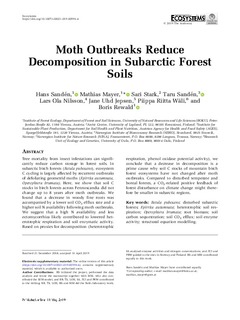| dc.contributor.author | Sandén, Hans | |
| dc.contributor.author | Mayer, Mathias | |
| dc.contributor.author | Stark, Sari | |
| dc.contributor.author | Sandén, Taru | |
| dc.contributor.author | Nilsson, Lars Ola | |
| dc.contributor.author | Jepsen, Jane Uhd | |
| dc.contributor.author | Wäli, Piippa Riitta | |
| dc.contributor.author | Rewald, Boris | |
| dc.date.accessioned | 2019-11-11T12:37:27Z | |
| dc.date.available | 2019-11-11T12:37:27Z | |
| dc.date.created | 2019-06-07T09:29:23Z | |
| dc.date.issued | 2019 | |
| dc.identifier.citation | Ecosystems. 2019, 1-13. | nb_NO |
| dc.identifier.issn | 1432-9840 | |
| dc.identifier.uri | http://hdl.handle.net/11250/2627725 | |
| dc.description.abstract | Tree mortality from insect infestations can significantly reduce carbon storage in forest soils. In subarctic birch forests (Betula pubescens), ecosystem C cycling is largely affected by recurrent outbreaks of defoliating geometrid moths (Epirrita autumnata, Operophtera brumata). Here, we show that soil C stocks in birch forests across Fennoscandia did not change up to 8 years after moth outbreaks. We found that a decrease in woody fine roots was accompanied by a lower soil CO2 efflux rate and a higher soil N availability following moth outbreaks. We suggest that a high N availability and less ectomycorrhiza likely contributed to lowered heterotrophic respiration and soil enzymatic activity. Based on proxies for decomposition (heterotrophic respiration, phenol oxidase potential activity), we conclude that a decrease in decomposition is a prime cause why soil C stocks of mountain birch forest ecosystems have not changed after moth outbreaks. Compared to disturbed temperate and boreal forests, a CO2-related positive feedback of forest disturbance on climate change might therefore be smaller in subarctic regions. Betula pubescens; disturbed subarctic forests; Epirrita autumnata; heterotrophic soil respiration; Operophtera brumata; root biomass; soil carbon sequestration; soil CO2 efflux; soil enzyme activity; structural equation modelling. | nb_NO |
| dc.language.iso | eng | nb_NO |
| dc.relation.uri | http://hdl.handle.net/11250/2600271 | |
| dc.rights | Navngivelse 4.0 Internasjonal | * |
| dc.rights.uri | http://creativecommons.org/licenses/by/4.0/deed.no | * |
| dc.title | Moth Outbreaks Reduce Decomposition in Subarctic Forest Soils | nb_NO |
| dc.type | Journal article | nb_NO |
| dc.type | Peer reviewed | nb_NO |
| dc.description.version | publishedVersion | nb_NO |
| dc.rights.holder | © 2019 The Author(s) | nb_NO |
| dc.subject.nsi | VDP::Zoologiske og botaniske fag: 480 | nb_NO |
| dc.subject.nsi | VDP::Zoology and botany: 480 | nb_NO |
| dc.subject.nsi | VDP::Landbruks- og Fiskerifag: 900 | nb_NO |
| dc.source.pagenumber | 1-13 | nb_NO |
| dc.source.journal | Ecosystems | nb_NO |
| dc.identifier.doi | 10.1007/s10021-019-00394-6 | |
| dc.identifier.cristin | 1703351 | |
| dc.relation.project | Norges forskningsråd: 244454 | nb_NO |
| dc.relation.project | EC/FP7/262693 | nb_NO |
| dc.relation.project | Andre: 138309 - The Academy of Finland | nb_NO |
| cristin.unitcode | 7677,2,0,0 | |
| cristin.unitname | Divisjon for skog og utmark | |
| cristin.ispublished | true | |
| cristin.fulltext | original | |
| cristin.qualitycode | 2 | |

